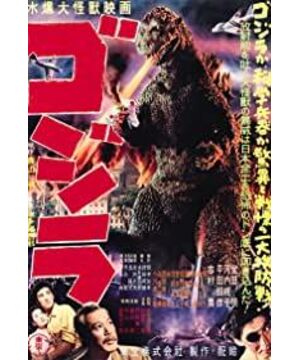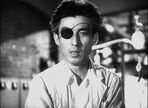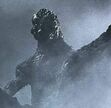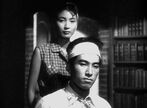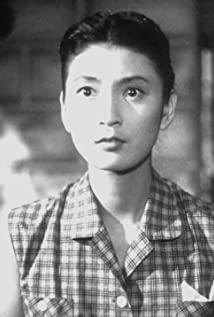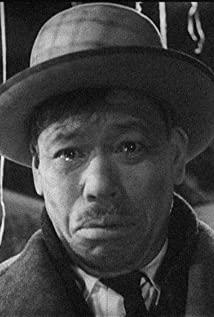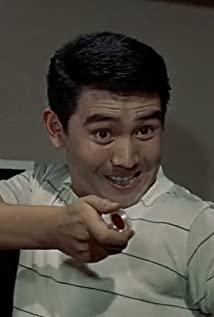A legendary monster was born in 1954. It brought fear and hope to people. It is a product of mankind and an incarnation of nature. The earth trembles wherever it goes, and people scream for it where it goes. He is the representative of Japanese monsters-Godzilla. 1954 coincided with the end of Japan’s economic recovery. People began to gradually escape the shadow of war and enter their daily lives. However, people still have a huge psychological shadow on the nuclear weapons once brought to Japan, so Godzilla did it. born. Godzilla can be said to represent the reflection of the Japanese people on World War II and the visualization of their fear of nuclear experiments. There are many articles on the reasons and implications of the image of Godzilla, and I will not discuss them too much here. Next, I will mainly analyze the first "Godzilla" movie that was born in 1954.
"Godzilla" tells the story of the emergence of Godzilla, a creature that was invaded by nuclear tests, and the confrontation between humans. Through a series of events inside, the theme of reflection on nuclear experiments and the confrontation between humans and nature is expressed.
In terms of narration, the film can be roughly divided into three parts, which also have different styles:
1. Discover Godzilla. This part is the beginning of the film, and the whole part is filled with a mysterious and terrifying atmosphere, as if it is strange talk. The disappearance of the ship, the dinosaurs mentioned by the survivors, media speculation and local legends, although Godzilla did not appear at this time, it left a strong impression on the audience and was immersed in this weird atmosphere.
2. Godzilla's struggle with humans. This part is more like the style of a disaster movie, the behemoth that acts at night, the self-defense force's painstaking attack plan, the destroyed Tokyo and the crying refugees, which shocked the audience deeply and once again reflected Godzilla. The horror and human powerlessness to face Godzilla. At the same time, it also implies a heavy blow to the Japanese people.
3. Destroy Godzilla. This part is more epic, with the sad music beginning and ending with the sad music, the whole part carries out this tragic atmosphere. Finally, the death of Godzilla and Serizawa brought the film to a climax and sublimation. Finally, facing the calm sea, the movie stopped abruptly.
Although these three parts have different styles, they are intertwined at the same time, forming a complete narrative structure. In this film, Godzilla is regarded as a concreteization of "nuclear", which shows the Japanese people's fear and fear of nuclear.
On the screen, the film is a good show of Godzilla's hugeness, mystery and horror. For example, Godzilla's first official appearance showed only one head, but the height of that head was indeed beyond the top of the mountain. In this way, Godzilla was shown to be huge, and through montages to show people's position on it. An impression-fear. After Godzilla left, he used the footprints left by Godzilla to highlight its hugeness. Except for the first and last time, Godzilla appeared at night. The huge monster moving in the dark night not only left the audience with a sense of horror but also a sense of mystery. The scene when Godzilla destroyed Tokyo later brought the horror of Godzilla to the culmination. And Godzilla's actions are all expressed in close-ups, which makes Godzilla's actions more tense. Although the music of this movie is monotonous, repeated use has left a strong impression on the audience. Although Godzilla’s roar in the film is just a simple technical synthesis, the combination of the destroyed Tokyo makes Godzilla domineering and also exaggerates the atmosphere.
After talking about the narrative and audiovisual language, I finally want to talk about a character in the film.
Dr. Serizawa, in my opinion, is the fullest and most individual character in this film. From his mysterious appearance to his final glorious death, he is more important than the male and female protagonists in the whole movie. In my opinion, the hero and heroine exist only to elicit this role. This character is very contrasting. He has a kind heart under the ugly appearance. He has developed weapons of mass destruction but wants to use them on the right path. From a few perspectives, I think this role represents Japan’s anti-war ideology. First of all, this character left scars on his face during the war, just like Japan that was devastated by nuclear bombs during World War II. The kindness in his heart represents the innocent people of Japan. The weapons he developed obviously symbolized nuclear bombs. It also symbolizes that people cannot use nuclear weapons in the right way.
As the first work of the "Godzilla" series, this movie surpasses many of the same type of monster movies of the same era, and it is technically far beyond the world level, and its ideological level has also raised the height of this work. So "Godzilla" left a strong mark in the history of world cinema. So far, Godzilla has gone through 62 years, from Japan to the world. Even if humans want to stop it, they cannot stop it. It will continue to roar, make the world shake for it, and let the world scream for it.
View more about Godzilla reviews


